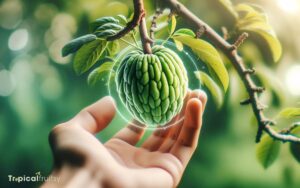Can You Eat Cherimoya Skin? No!
Cherimoya skin is generally not recommended for consumption. While the flesh of the cherimoya fruit is edible and highly praised for its creamy texture and sweet flavor, the skin is tough, potentially difficult to digest, and may contain toxins that could be harmful if ingested.
The skin of the cherimoya fruit, also known as the custard apple, is not commonly eaten due to several factors:
Despite the skin being inedible, cherimoya flesh can be enjoyed after proper preparation. The fruit should be cut open, and the flesh can be scooped out, avoiding the seeds and skin.
Enjoy the luscious and sweet cherimoya flesh, but leave the tough skin behind for safety and taste.

Key Takeaway
Edibility Guide for Cherimoya: Flesh, Skin, and Seeds
| Part of Cherimoya | Edibility | Notes |
|---|---|---|
| Flesh | Edible | Cherimoya flesh is sweet and creamy, often compared to a blend of banana, pineapple, and strawberry. |
| Skin | Not Edible | The skin is tough and may contain harmful toxins; it is commonly discarded. |
| Seeds | Not Edible | Seeds are hard and can be toxic if crushed or chewed. |
Understanding Cherimoya Fruit
The cherimoya, a tropical fruit native to the Andes, is known for its creamy texture and sweet flavor profile that combines notes of banana, pineapple, and papaya.
Often called ‘the custard apple,’ this heart-shaped fruit has a flesh that’s not only delectable but also packed with essential nutrients.
It’s a rich source of vitamin C, providing a significant portion of the daily requirement, which is vital for immune system function.
Cherimoya also contains dietary fiber, important for digestive health, and a range of B vitamins, contributing to energy metabolism.
Moreover, cherimoya offers a variety of minerals such as potassium, which helps maintain normal blood pressure. For those looking to enhance their diet, cherimoya’s nutrient density makes it a valuable addition.
The Edibility of Cherimoya Skin
When considering the edibility of cherimoya skin, it’s important to address potential toxicity concerns, as some studies suggest the presence of harmful compounds.
The skin’s taste and texture may also influence its suitability for consumption, with many finding it unpalatable compared to the creamy flesh inside.
Lastly, appropriate preparation methods can affect whether the skin can be safely consumed, emphasizing the need for informed culinary approaches.
Skin Toxicity Concerns
Rarely is cherimoya skin considered safe to eat due to its potentially toxic compounds. The skin contains alkaloids, such as annonacin, which can have neurotoxic effects.
These substances are linked to adverse health outcomes, prompting caution among experts and consumers alike.
The table below highlights key aspects of cherimoya skin’s potential toxicity:
| Concern | Detail |
|---|---|
| Toxic Compounds | Annonacin (neurotoxin) |
| Health Risks | Neurological disorders |
| Consumption Advice | Avoid eating the skin |
| Expert Consensus | Skin is potentially harmful |
| Safety Measures | Consume flesh only |
It’s clear that while the flesh of cherimoya is highly praised for its flavor and nutritional value, the skin does not share the same profile.
Taste and Texture
Despite the toxicity concerns, cherimoya skin’s tough and bitter taste, along with its gritty texture, further dissuades consumption.
The skin contains compounds that humans find unpalatable, which nature likely evolved as a defense mechanism to protect the fruit from predators.
When someone attempts to eat the skin, they’re met with a harsh, astringent flavor that contrasts starkly with the sweet and creamy flesh inside. This unpleasant taste serves as an immediate deterrent, signalling that it’s not meant to be eaten.
In addition to flavor, the skin’s fibrous and rough texture is difficult to chew and digest, providing a tactile reminder of its inedibility.
Understanding these characteristics, it’s important to know how to properly prepare cherimoya before enjoying its delectable interior.
Preparation Methods
To prepare a cherimoya for consumption, it’s essential to remove the skin, which isn’t only inedible but also potentially harmful if ingested.
The skin contains annonacin, a neurotoxic compound that can have adverse effects on one’s health. Therefore, it’s crucial to peel the fruit properly.
Begin by slicing the cherimoya in half. The creamy flesh inside can then be scooped out with a spoon, avoiding the skin and the black seeds, which are also toxic.
For recipes requiring cubed cherimoya, place the flesh on a cutting board and cut it into chunks, again taking care to discard the skin.
Nutritional Profile Analysis
Within the cherimoya’s flesh, a range of essential nutrients can be found, yet the skin’s nutritional profile differs significantly. The flesh is rich with vitamins, minerals, and fiber.
- Vitamins: Cherimoya provides vitamin C, which supports the immune system, and B vitamins for energy metabolism.
- Minerals: Notable minerals include potassium for heart health and magnesium, which plays a role in over 300 enzymatic reactions.
- Fiber: A high fiber content aids in digestion and can help regulate blood sugar levels.
In contrast, the skin may contain potentially harmful compounds and is generally not recommended for consumption.
Understanding the nutritional profile of cherimoya is crucial for those seeking to incorporate it into a balanced diet.
Preparing Cherimoya for Consumption
Before enjoying the creamy texture and tropical flavors of cherimoya, consumers must select a ripe fruit and understand the proper way to prepare it.
They’ll need to remove the skin, which isn’t typically consumed, using a technique that preserves the fruit’s integrity.
Identifying the edible parts, such as the flesh while discarding the seeds, ensures a safe and enjoyable eating experience.
Ripe Fruit Selection
Selecting a ripe cherimoya is essential for optimal flavor and texture, as the skin isn’t typically consumed.
When cherimoya is at its peak ripeness, it offers a creamy, custard-like flesh that’s both sweet and tangy, providing not just a treat for the taste buds but also a wealth of vitamins and minerals.
To ensure you’re picking a ripe fruit, consider these cues:
- The skin should give slightly under gentle pressure, much like a ripe avocado.
- Its color turns from bright green to a more muted, yellowish-green as it ripens.
- A sweet, tropical fragrance is often a telltale sign that the cherimoya is ready to be enjoyed.
Choosing the right cherimoya can turn your fruit experience from mundane to extraordinary, while also maximizing the health benefits it offers.
Skin Removal Technique
Although the cherimoya’s skin isn’t edible, you’ll find that removing it’s a straightforward process, ensuring you can enjoy the fruit’s delectable flesh with ease.
To start, wash the fruit thoroughly to eliminate any surface contaminants. With a sharp knife, slice the cherimoya in half, exposing the creamy interior. The skin, which may contain toxic compounds, should be discarded to avoid any health risks.
Gently scoop out the flesh with a spoon, being mindful to remove any black seeds, as they aren’t safe for consumption either. The fruit can be eaten on its own or added to salads, smoothies, and desserts.
Proper skin removal not only enhances the eating experience but also ensures that you can savor the cherimoya’s benefits without any concerns.
Edible Parts Identification
Once you’ve peeled away the cherimoya’s inedible skin, the soft, sweet flesh inside is ready to be enjoyed, either by itself or incorporated into various dishes. The edible parts of cherimoya aren’t only delectable but also packed with health benefits.
To properly prepare cherimoya for consumption, keep in mind these critical points:
- Remove all seeds: Cherimoya seeds are toxic if crushed or chewed, so they must be discarded.
- Savor the pulp: The creamy texture and rich flavor can enhance smoothies, desserts, and salads.
- Utilize the flesh: Full of vitamins C and B6, fiber, and antioxidants, the flesh supports immune health and digestion.
Indulging in the cherimoya’s edible flesh can be a delightful and nutritious addition to any diet.
Potential Health Risks
Consuming cherimoya skin may pose health risks due to the presence of toxic compounds such as annonacin.
Annonacin is a neurotoxin linked to neurodegenerative diseases when consumed in large quantities. It’s important to note that the fruit’s flesh contains lower levels of these compounds and is generally considered safe to eat.
The skin, however, has a higher concentration of annonacin and other alkaloids that can be harmful.
Eating cherimoya skin may lead to short-term digestive issues, and there’s concern that long-term consumption could contribute to more severe health problems.
Therefore, health experts recommend avoiding the skin and sticking to the fruit’s flesh to minimize potential risks.
Always consult a health professional if you have concerns about consuming new or exotic foods.
Alternative Uses for Cherimoya Skin
How, then, can the inedible skin of the cherimoya be repurposed, given its unsuitability for consumption? The tough exterior, while not fit for eating, offers alternative uses that contribute to sustainability and waste reduction.
Here are three compelling ways to utilize cherimoya skin:
- Composting: Cherimoya skins can be added to compost bins, where they break down and enrich the soil with nutrients, supporting plant growth.
- Natural Dye: The skins contain pigments that can be used in natural dyeing processes for fabrics, offering a touch of organic color.
- Pest Repellent: When dried and scattered in gardens, the bitter compounds in cherimoya skin can serve as a natural deterrent to pests.
These uses highlight the skin’s value beyond the fruit’s flesh and underscore a commitment to eco-friendly practices.
Enjoying Cherimoya Safely
Transition from repurposing cherimoya skin to ensuring the fruit’s safe consumption by meticulously removing the inedible peel and discarding any seeds, which contain toxic compounds.
Cherimoya enthusiasts must be cautious, as the seeds have been found to harbor toxic alkaloids, such as annonacin, that can pose health risks if ingested.
It’s imperative to consume only the creamy flesh of the cherimoya, which isn’t just safe but also highly nutritious, offering a wealth of vitamins, minerals, and antioxidants.
When preparing cherimoya, one should always slice the fruit open and scoop out the flesh, being careful to avoid blending seeds with the pulp.
By following these safety guidelines, individuals can enjoy the exotic flavors of cherimoya without compromising their well-being.
Conclusion
While cherimoya’s flesh is a nutritious bounty, its skin isn’t fit for consumption due to potential toxins. Preparing the fruit with care, consumers can relish its benefits while sidestepping health risks.
Though not edible, the skin’s alternative uses, such as composting, exemplify a ‘waste not, want not’ philosophy.
As one navigates the dietary seas, cherimoya remains a luscious port of call, provided one steers clear of the inedible rind.






